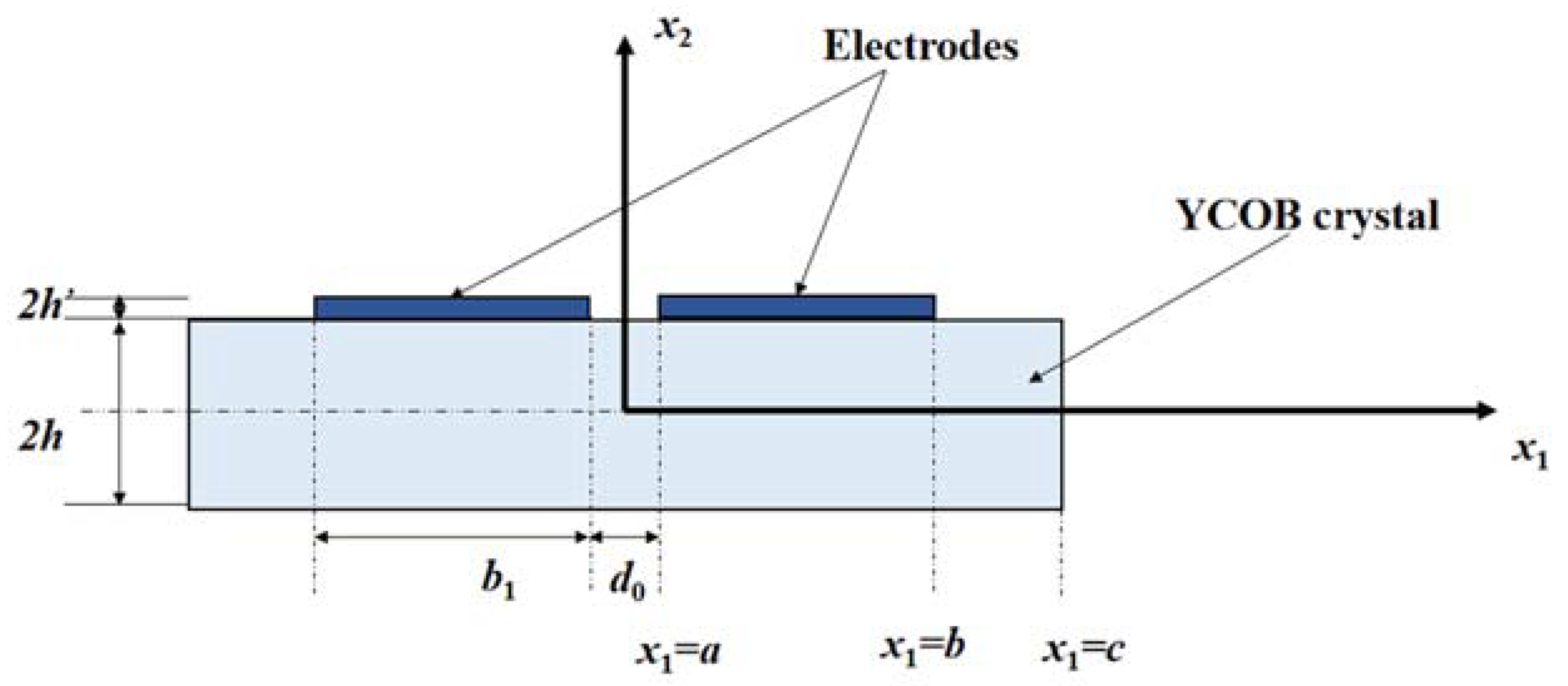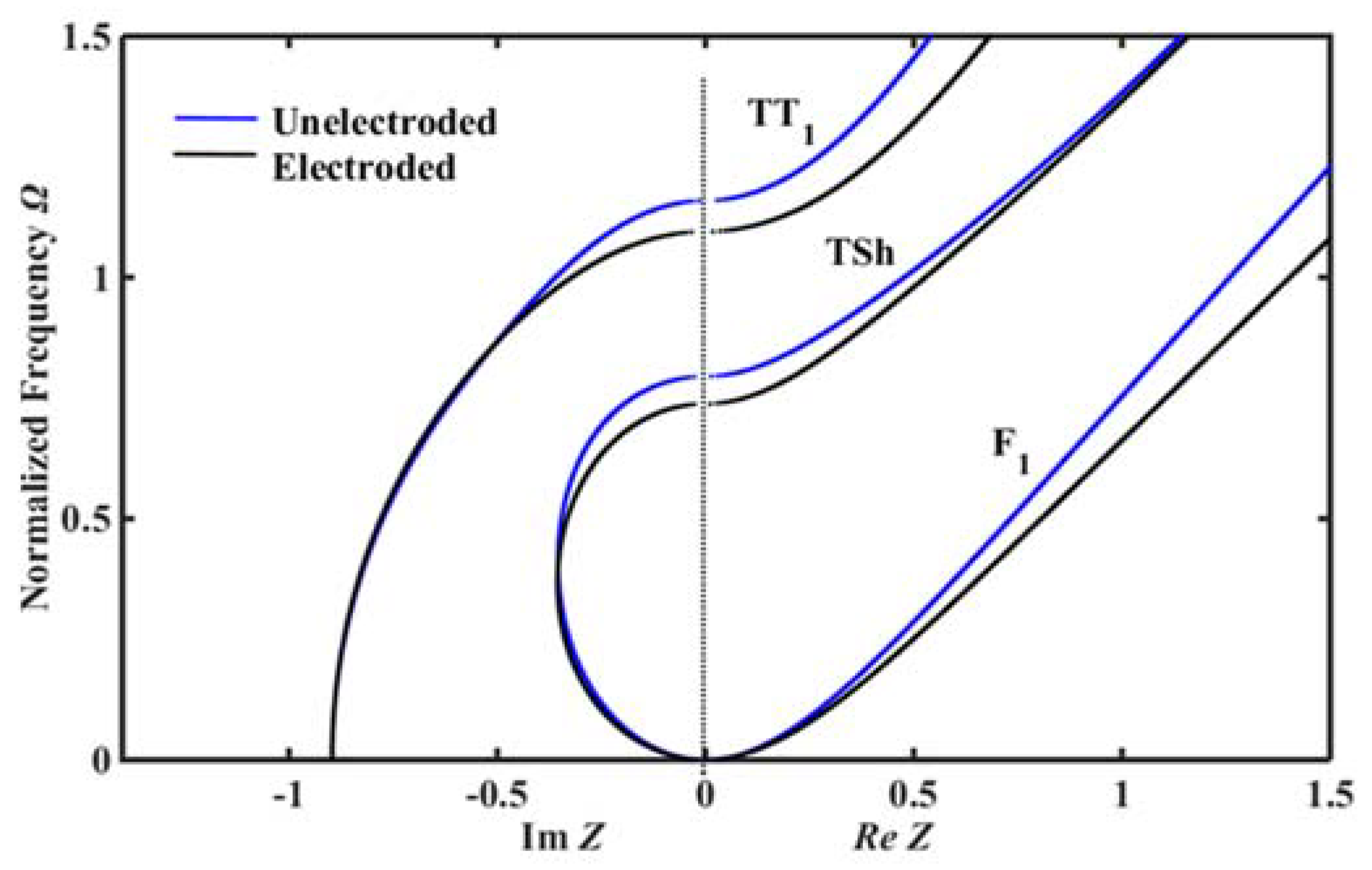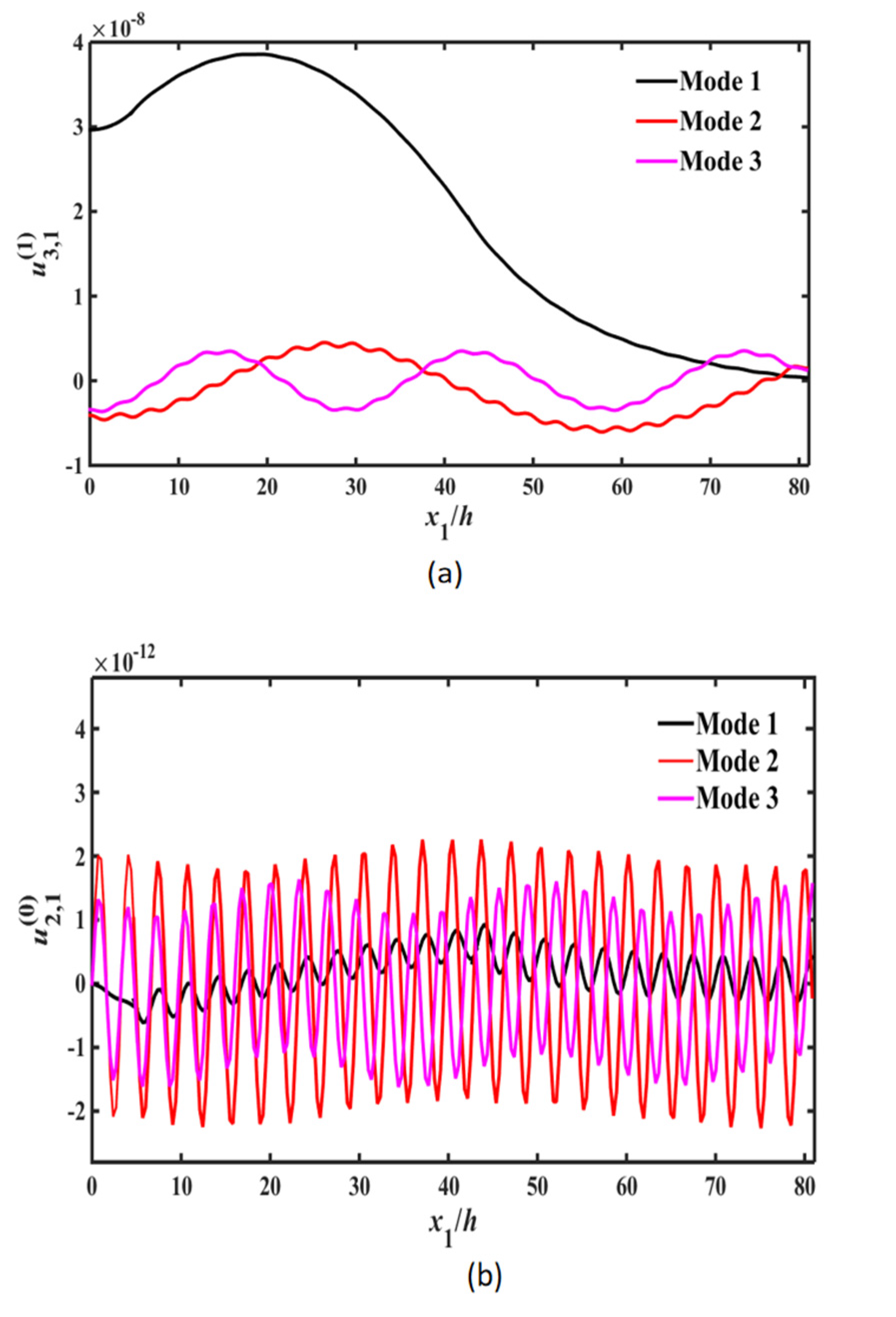Resonance Analysis of Piezoelectric Bulk Acoustic Wave Devices Based on YCOB Crystals with Monoclinic Symmetry Excited by Lateral Electric Fields
Abstract
:1. Introduction
2. Governing Equations
3. Dispersion Property and Frequency Spectra
4. Electrically Forced Vibrations of Finite Crystal Plates
4.1. Central Unelectroded Area with
4.2. Electroded Area with
4.3. Outer Unelectroded Area with
4.4. Boundary and Continuity Conditions
5. Results and Discussion
5.1. Mode-Coupling Analysis
5.2. Effects of Electrode Parameters on the Device’s Vibration Performances
5.3. Frequency Shifts Caused by the Added Mass and Effects of Electrode Parameters on the Mass Sensitivity
6. Conclusions
Author Contributions
Funding
Institutional Review Board Statement
Informed Consent Statement
Data Availability Statement
Conflicts of Interest
References
- Abe, T.; Higuchi, M. A monolithic QCM array designed for mounting on a flow cell. IEEE Sens. J. 2011, 11, 86–90. [Google Scholar] [CrossRef]
- Qiu, H.; Li, F.X. In-plane selective excitation of arbitrary vibration modes using thickness-shear (d15) piezoelectric transducers. Smart Mater. Struct. 2022, 31, 03LT01. [Google Scholar] [CrossRef]
- Qian, Z.H.; Kishimoto, K.; Yang, J.S. Propagation of thickness-twist wave in a piezoelectric cramic plate in contact with viscous fluids. Acta Mech. 2009, 212, 263–270. [Google Scholar] [CrossRef]
- Zhang, H.; Gao, Y. Acoustic vortex beam generation by a piezoelectric transducer using spiral electrode. Chin. Phys. Lett. 2019, 36, 114302. [Google Scholar] [CrossRef]
- Liu, N.; Yang, J.S.; Jin, F. Transient thickness-shear vibration of a piezoelectric plate of monoclinic crystals. Int. J. Appl. Electromagnet. Mech. 2012, 38, 27–37. [Google Scholar] [CrossRef]
- Li, P.; Jin, F.; Yang, J.S. Effects of semiconduction on electromechanical energy conversion in piezoelectrics. Smart Mater. Structm 2012, 24, 025021. [Google Scholar] [CrossRef]
- Hu, Y.T.; Yang, J.S.; Zeng, Y.; Jiang, Q. A high-sensitivity, dual-plate, thickness-shear mode pressure sensor. IEEE Trans. Ultrason. Ferroelectr. Freq. Contr. 2006, 53, 2193–2197. [Google Scholar] [CrossRef]
- Wang, S.H.; Shen, C.Y.; Lin, Y.M.; Du, J.C. Piezoelectric sensor for sensitive determination of metal ions based on the phosphate-modified dendrimer. Smart Mater. Struct. 2016, 25, 085018. [Google Scholar] [CrossRef]
- Hu, Y.H.; French, L.A.; Radecsky, K.; da Cunha, M.P.; Millard, P.; Vetelino, J.F. A lateral field excited liquid acoustic wave sensor. IEEE Trans. Ultrason. Ferroelectr. Freq. Contr. 2004, 51, 1373–1380. [Google Scholar] [CrossRef]
- Hu, Y.H.; Pinkham, W.; Jr, L.A.F.; Frankel, D.; Vetelino, J.F. Pesticide detection using a lateral bulk excited acoustic wave sensor. Sens. Actuators B Chem. 2005, 108, 910–916. [Google Scholar] [CrossRef]
- Hempel, U.; Lucklum, R.; Hauptmann, P.R. Lateral field excited acoustic wave devices: A new approach to bio-Interface sensing. In Proceedings of the 2007 IEEE Frequency Control Symposium, Geneva, Switzerland, 29 May–1 June 2007; pp. 426–430. [Google Scholar]
- Ma, T.F.; Zhang, C.; Feng, G.P. Lateral field excited Y-cut langasite bulk acoustic wave sensor. Sens. Actuators B Chem. 2011, 153, 50–53. [Google Scholar] [CrossRef]
- Wang, W.Y.; Zhang, C.; Zhang, Z.T.; Liu, Y.; Feng, G.P. Three operation modes of lateral-field-excited piezoelectric devices. Appl. Phys. Lett. 2008, 93, 242906. [Google Scholar] [CrossRef]
- Johnson, J.A.; Kim, K.; Zhang, S.J.; Wu, D.; Jiang, X.N. High-temperature acoustic emission sensing tests using a Yttrium calcium oxyborate sensor. IEEE Trans. Ultrason. Ferroelectr. Freq. Contr. 2014, 61, 805–814. [Google Scholar] [CrossRef]
- Zhang, S.J.; Fei, Y.T.; Chai, B.H.T.; Frantz, E.; Snyder, D.W.; Jiang, X.N.; Shrout, T.R. Characterization of piezoelectric single crystal YCa4O(BO3)3 for high temperature applications. Appl. Phys. Lett. 2008, 92, 202905. [Google Scholar] [CrossRef]
- Borodina, I.A.; Zaitsev, B.D.; Teplykh, A.A.; Shikhabudinov, A.M.; Kuznetsova, I.E. Array of piezoelectric lateral electric field excited resonators. Ultrasonics. 2015, 62, 200–202. [Google Scholar] [CrossRef]
- Zhang, S.J.; Fei, Y.T.; Frantz, E.; Snyder, D.W.; Chai, B.H.T.; Shrout, T.R. High-temperature piezoelectric single crystal ReCa4O(BO3)3 for sensor applications. IEEE Trans. Ultrason. Ferroelectr. Freq. Contr. 2008, 55, 2703–2708. [Google Scholar] [CrossRef]
- Yu, F.P.; Duan, X.L.; Zhang, S.J.; Yu, Y.J.; Ma, T.F.; Zhao, X. Temperature dependence of electro-elastic properties of yttrium calcium oxyborate single crystals. In Proceedings of the Symposium on Piezoelectricity, Acoustic Waves, and Device Applications (SPAWDA), Shanghai, China, 23–25 November 2012; pp. 293–297. [Google Scholar]
- Zu, H.Z.; Wu, A.H.; Wang, Y.Z.; Zhang, S.J.; Shrout, T.R.; Wang, Q.M. Properties of single crystal piezoelectric Ca3TaGa 3Si2O14 and YCa4O(BO3)3 resonators at high-temperature and vacuum conditions. Sens. Actuators A Phys. 2014, 216, 167–175. [Google Scholar] [CrossRef]
- Yu, F.P.; Zhang, S.J.; Zhao, X.; Yuan, D.R.; Wang, Q.M.; Shrout, T.R. High temperature piezoelectric properties of yttrium calcium oxyborate single crystals. Phys. Status Solidi-R. 2010, 4, 103–105. [Google Scholar] [CrossRef]
- Liu, B.; Jiang, Q.; Xie, H.M.; Yang, J.S. Energy trapping in high-frequency vibrations of piezoelectric plates with partial mass layers under lateral electric field excitation. Ultrasonics 2011, 51, 376–381. [Google Scholar] [CrossRef]
- Liu, B.; Jiang, Q.; Hu, Y.T.; Yang, J.S. High-frequency vibrations of piezoelectric plates driven by lateral electric fields. Int. J. Eng. Sci. 2011, 49, 1435–1442. [Google Scholar] [CrossRef]
- Ma, T.F.; Zhang, C.; Wang, W.Y.; Zhang, Z.T.; Feng, G.P. Optimal electrode shape and size of lateral-field-excited piezoelectric crystal resonators. IEEE Trans. Ultrason. Ferroelectr. Freq. Contr. 2011, 58, 263–266. [Google Scholar]
- Yang, J.S. The Mechanics of Piezoelectric Structures; World Scientific: Singapore, 2006. [Google Scholar]
- Mindlin, R.D. High frequency vibrations of piezoelectric crystal plates. Int. J. Solids Struc. 1972, 8, 895–906. [Google Scholar] [CrossRef]
- Chen, H.; Wang, J.; Du, J. Electrically Forced Vibrations of Partially Electroded Rectangular Quartz Plate Piezoelectric Resonators. Int. J. Acoust. Vib. 2017, 22, 161–166. [Google Scholar] [CrossRef]









Publisher’s Note: MDPI stays neutral with regard to jurisdictional claims in published maps and institutional affiliations. |
© 2022 by the authors. Licensee MDPI, Basel, Switzerland. This article is an open access article distributed under the terms and conditions of the Creative Commons Attribution (CC BY) license (https://creativecommons.org/licenses/by/4.0/).
Share and Cite
Chen, D.; Zhao, P.; Sun, F.; Ma, T.; Yuan, L.; Wu, R.; Li, P.; Qian, Z. Resonance Analysis of Piezoelectric Bulk Acoustic Wave Devices Based on YCOB Crystals with Monoclinic Symmetry Excited by Lateral Electric Fields. Crystals 2022, 12, 542. https://doi.org/10.3390/cryst12040542
Chen D, Zhao P, Sun F, Ma T, Yuan L, Wu R, Li P, Qian Z. Resonance Analysis of Piezoelectric Bulk Acoustic Wave Devices Based on YCOB Crystals with Monoclinic Symmetry Excited by Lateral Electric Fields. Crystals. 2022; 12(4):542. https://doi.org/10.3390/cryst12040542
Chicago/Turabian StyleChen, Dudu, Peng Zhao, Fei Sun, Tingfeng Ma, Lili Yuan, Rongxing Wu, Peng Li, and Zhenghua Qian. 2022. "Resonance Analysis of Piezoelectric Bulk Acoustic Wave Devices Based on YCOB Crystals with Monoclinic Symmetry Excited by Lateral Electric Fields" Crystals 12, no. 4: 542. https://doi.org/10.3390/cryst12040542
APA StyleChen, D., Zhao, P., Sun, F., Ma, T., Yuan, L., Wu, R., Li, P., & Qian, Z. (2022). Resonance Analysis of Piezoelectric Bulk Acoustic Wave Devices Based on YCOB Crystals with Monoclinic Symmetry Excited by Lateral Electric Fields. Crystals, 12(4), 542. https://doi.org/10.3390/cryst12040542






